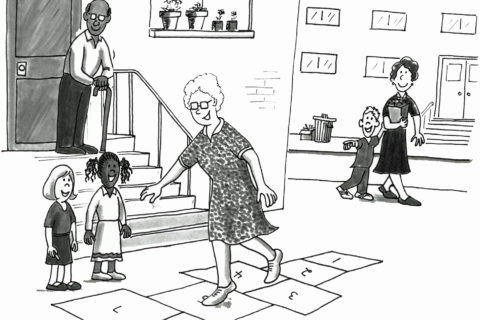
I have lived in the US now for 48 years. So for almost half a century I have been a patient of America’s health care system and have had to make life-and-death choices for my near and dear ones.
While serving on the boards and advisory boards of health care providers for over 20 years, I have learned about the challenges of the business model of health care systems. In board rooms and social settings, I have also heard experts, consultants, and physicians candidly sharing their thoughts about patient care.
The doctor-patient relationship in the US is sacred. I have yet to come across a patient who does not trust his or her own doctor. The health care system is however much too complex to navigate through, for most.
By no means do I know the answers for fixing it, but a new directional move is mandatory.
The closest analogy to health care is the college education system in the US. We have very affordable community colleges, public universities, private universities, and then private ivy league colleges. The costs from one to the other vary considerably.
Similarly, in N. California we have community hospitals, membership-driven hospitals like Kaiser, private hospitals, and University hospitals like UC San Francisco and Stanford.
Comparing health care to colleges will make further sense when we examine it further.
Business Model
In America, the government pays for those 65 years and older and the very poor. The government pays “significantly less (e.g., 30-50 percent) than the physician’s usual fee… as well as for surgical and diagnostic procedures.” On top, there are 31 million uninsured, who also need to be taken care of.
An estimated 10,000 people turn 65 every day in America, moving to government-provided Medicare. They are placing an increasing financial burden on the medical systems.
In California, S.B. 1953 requires all California hospitals to spend billions of dollars by 2030 to comply with new requirements to improve their resistance to earthquakes, but the state did not provide the funding for retrofitting.
Privately insured and their employers are making up for the shortfall. In not-for-profit health care systems and university medical centers donations also help.
Bob Reed, the former CFO of Sutter Health and an industry veteran testified recently in a recent antitrust trial against Sutter that running hospitals in California is “a very difficult economic proposition.”
However, cost-sharing is necessary for the providers when they balance out the higher premium paying employers with government-paid insurances, just as insurance companies average the risk of sicker patients with the healthier ones to offer affordable prices.
Price of Choices
American consumers like choices.
When patients exercise preferences for certain physicians and/or want more timely appointments, the doctor must leave open space on their schedule to accommodate same-day appointments. If the same-day drop-in patients don’t come, doctors’ time gets wasted, driving costs higher.
Then there is a choice of which medical system the patient may go to for different procedures or specialty doctors. American consumers like the flexibility to choose which makes the volume less predictable and the cost of care higher.
Even though the US ranks low among high-income countries in traditional international measures of healthcare, patients around the world, who can afford, would want to be treated for life-threatening illnesses here and nowhere else. We remain the gold standard.
Admittedly, our costs remain high but also the quality of care is high.
According to Bob Reed, “health care is probably best delivered in a nonprofit setting.” He admitted that it is a bad model for a provider to get paid for patients’ ailments. Illness cannot be a source of making money for any organization. A not-for-profit has no shareholders, so profits can be plowed back into the business to take care of the community. Under this model, the system will achieve its mission. Bob Reed is a very astute observer.
Public health is too important a mission to be left to a capitalist, market-driven approach.
In Jan 2018, “Haven, the joint venture formed by three of America’s most powerful companies Amazon, Berkshire Hathaway, and JPMorgan Chase was announced to lower costs and improve outcomes in health care”. Haven folded in February 2021. “The move to shutter Haven may be a sign of how difficult it is to radically improve American health care”, the same CNBC journalist concluded.
There are no magical movements. And trying to change America’s health care system overnight can be dangerous. However gradual shift towards a single-payer, with employers’ participation and multiple categories of providers, could serve us well, just like our college education system. If both private university Stanford and public university UC Berkeley can deliver great education and produce Nobel Laureates, so can multiple healthcare providers under different umbrellas, without sacrificing quality.
We have individual musicians in this orchestra in place but need a conductor who can get them to play in harmony.








Vijay K Gupta
"Admittedly, our costs remain high but also the quality of care is high." I guess it depends on what we mean by "quality of care."
To me, US health care is like a shiny, colorful, and flawless apple that looks very appealing, tastes crisp, pacifies immediate hunger, but has very little nutrition.
Specifically, the US has the shiniest hospitals and the latest (and most expensive) diagnostic machines and drugs, yet it has the lowest life expectancy and highest infant mortality in the developed world. In 2021, the life expectancy gap between the US and other developed countries widened to five years. Even when we look at the ‘quality adjusted life years (QALY),’ the US is among the lowest on that metric.
So in terms of both the quality and quantity of healthy life, we are at the bottom of the heap. Yet we are never tired of saying that we have the best quality of healthcare in the world. Why?
This widespread illusion about the quality of healthcare actually prevents us from making more fundamental changes to our healthcare system.
R. Paul Singh
If we don’t agree that there is a problem we can’t fix it. There are many bankruptcies that are caused by our healthcare being priced not as a life saving service but as a commodity. The more you buy the less you pay.
At some point in the past my son was I a a major accident for which he was hospitalized for 5 days in Stanford and they sent us a bill of over $250k but their agreed to rate for that service with Kaiser was less than $50k which is what Kaiser paid as our healthcare provider.
Dominique Trempont
I experienced the US healthcare system in business 25 years ago. We had a smart card solution that had the potential of streamlining (-50%) most of the healthcare administrative tasks and cost duplications. Enormous waste. These solutions were widely implemented in Europe and Asia. I recruited top players in Washington on the Board. We could not have ONE deployment going. Unions fighting, insurance fighting, the whole system was fighting etc. I decided to pull out and focus elsewhere.
Matt Granovetter
Thought provoking. Thx, Venta.
We now know from Covid vaccines that corruption contaminates both non-profit and profit health care. Decisions are made based on profit and agenda in both systems rather than what’s best for people. So I doubt that an orchestra leader will be safe. Unless he’s a saint. Unfortunately, not all doctors or researchers are actually dedicated to better health. If they were, they would be promoting healthy lifestyle and protocols to boost immune systems instead of the "one solution fits all vaccines," which turned out to do the opposite. Unfortunately, the press is mostly a mockingbird mockery of investigative reporting, siding with those who pay them off. So many viewers become brainwashed.
On the bright side, the freedom of speech in the newest technological social media allows people to think for themselves based on evidence and common sense. So we hope to survive by our own power to analyze the facts and pass on to others the truth.
Hemant Lall
The two most basic needs of a person are health and safety. The government does an excellent job of protecting its people with its military might. Why not the health of the people, too? I agree with Vinita — a shift towards a single-payer system is the way to go.
Hemant
Prakash
I guess you haven’t seen Michael Moore’s movie sicko. From whatever I have read and seen, my impression is that it (what goes for US healthcare system) is a predatory money-grabbing machine.
Just one example should suffice. FT had published an article on the cost of Mebendazole tablet in US. At most any place in the world, it is equivalent to a few cents per tablet. In the US it was ~450 US dollars/tablet!
There are many other examples. The story of epipen and so on. This article helps confirm my hypothesis that people who have a lot of money are unable to reach or see some facts.